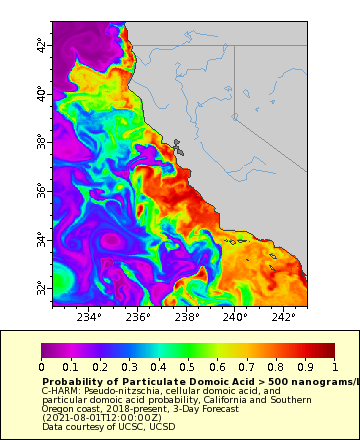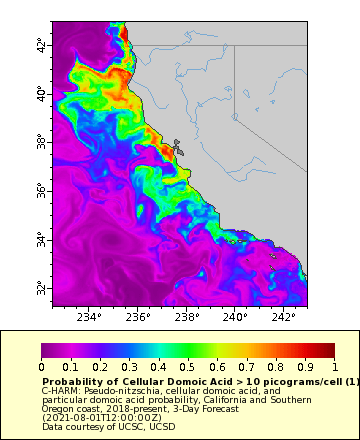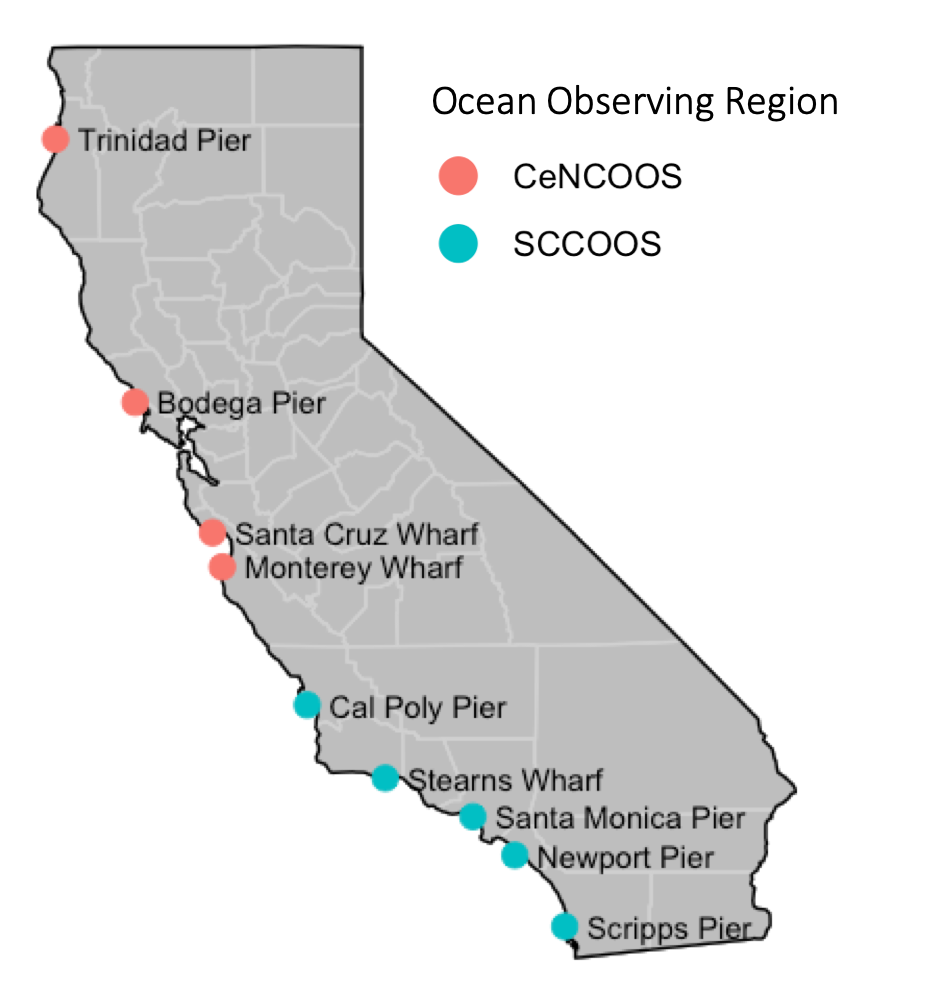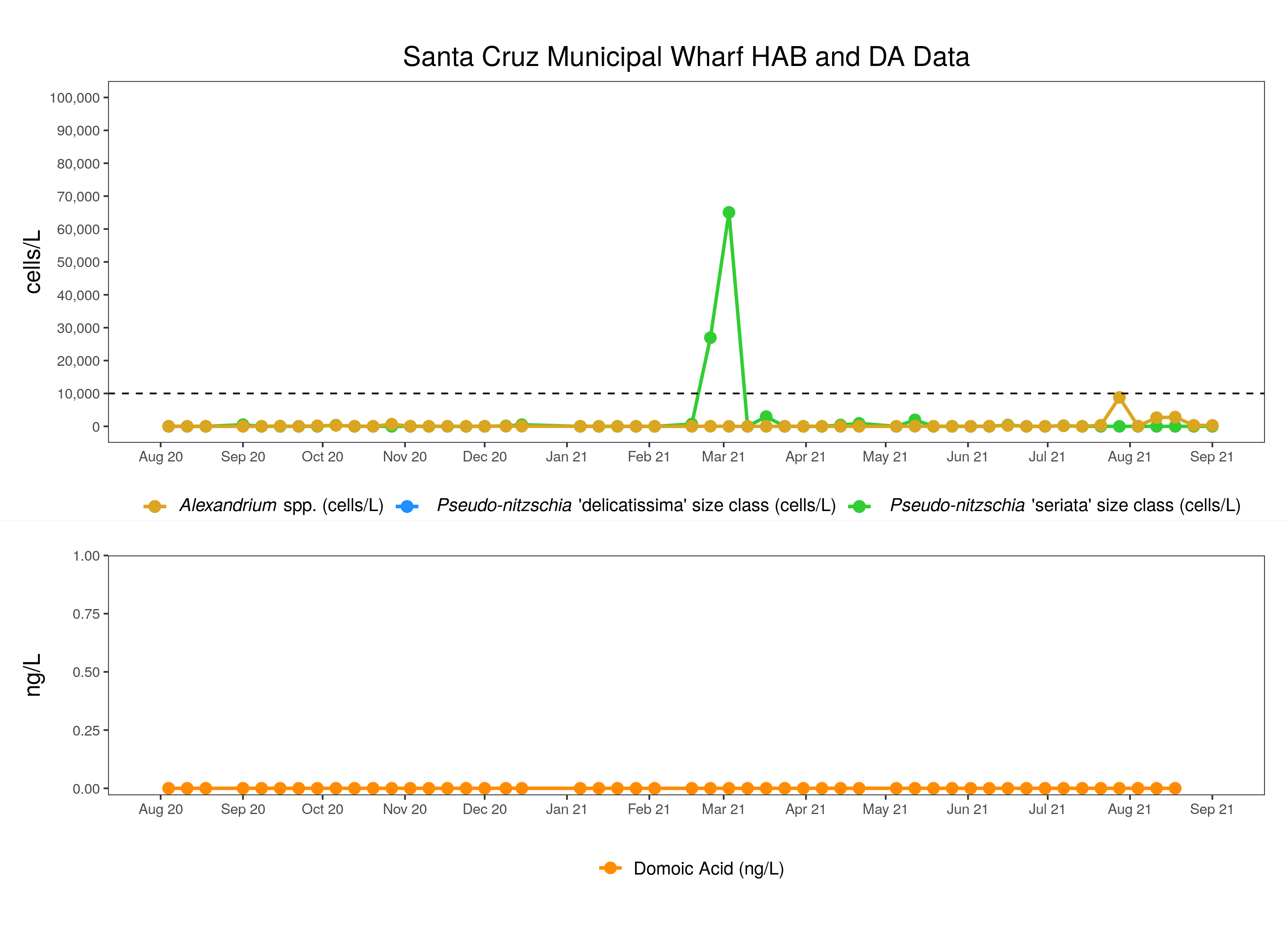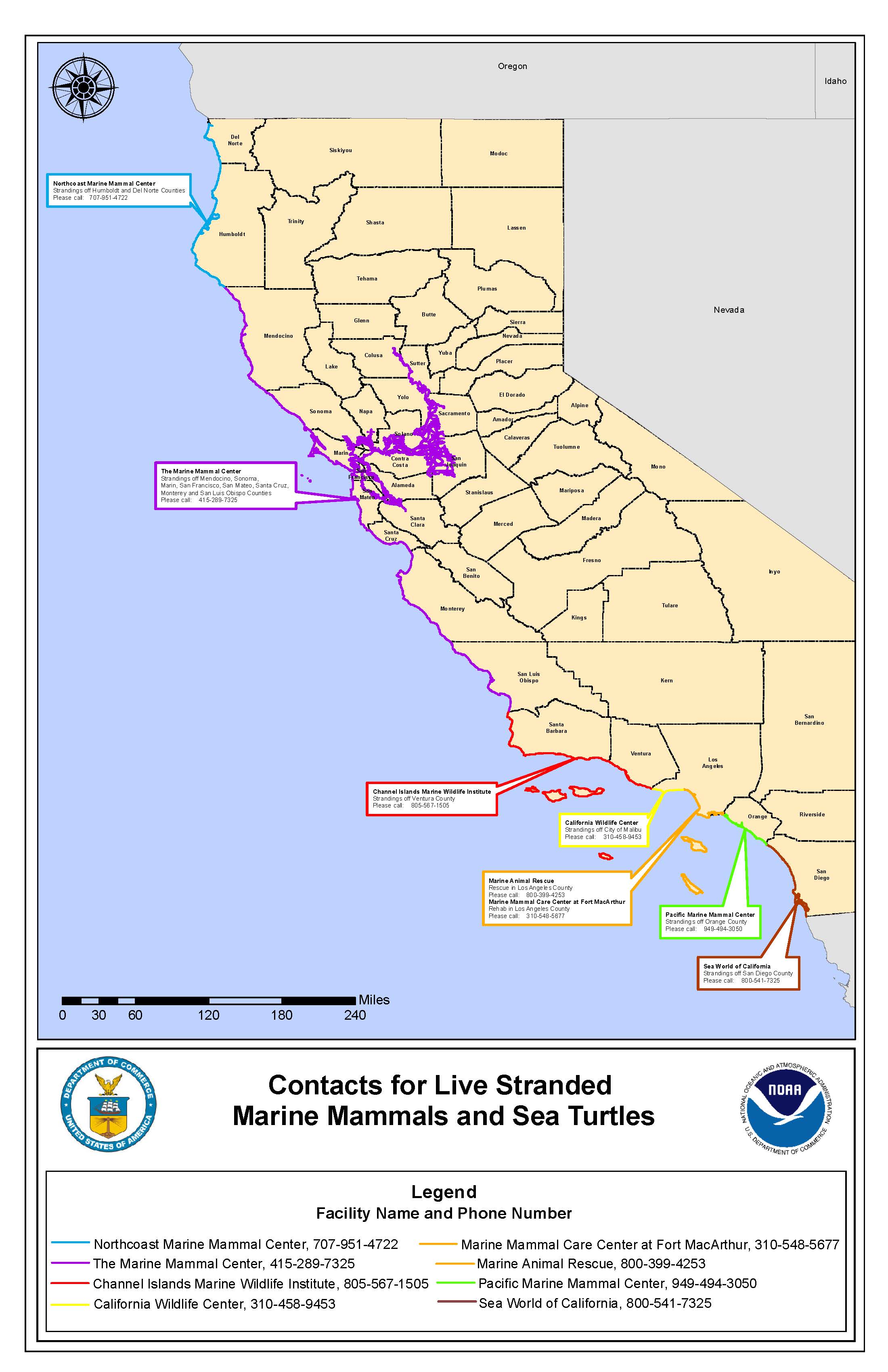Pseudo-nitzschia - C-HARM tells us where conditions are suitable for species of the diatom Pseudo-nitzschia spp. (all size classes) to grow well and where they might be more likely to produce the deadly neurotoxin, domoic acid (DA). C-HARM predictions in August suggest patchy suitable habitat for Pseudo-nitzschia spp., similar to that predicted for July. Northern California and southern Oregon are persistent hot spots along with much of central California. Early in the month, very high probabilities were predicted for the entire coast from the Santa Barbara Channel to Oregon, followed by localized hot spots around San Francisco Bay/Half Moon Bay/Monterey Bay and the Pt. Conception and Santa Barbara Channel area. High bloom probabilities were more confined to the nearshore zones of the Southern California Bight with hot spots occasionally predicted for San Pedro Bay and Orange/San Diego Counties. Given ongoing COVID-19 sampling restrictions and delays that continue to hamper our ability to acquire timely HABMAP observations from piers, most but not all piers are currently making data available. There was no notable Pseudo-nitzschia presence at any of the pier sites where data were reported in August. The Relative Abundance Index (RAI) for the Pseudo-nitzschia "seriata" size class recorded by the California Department of Public Health (CDPH) reached "Common" levels (10-49%) - in San Diego (Scripps Pier), Santa Barbara, San Francisco (Pacifica Pier), and Humboldt C. (Trinidad Pier) - and was "Present" at may sites up and down the coast, suggesting a statewide presence of the more toxigenic group at moderate levels (not bloom levels).
Moderate to very high C-HARM probabilities (50-100%) for particulate domoic acid (pDA) were predicted for large sections of the California coastline in August, beginning with a focus on the central coast and then expanding to most of the coastline throughout the month. The risk of high pDA grew notably along the North Coast by the end of August, as did much of the Southern California Bight. The highest probabilities for cellular DA (cDA) were focused in a narrower band along the coast in central and northern California, with mostly low probabilities south of Pt. Conception. By the end of August, high cDA probabilities were confined to the North Coast regions. Marine mammal strandings from potential DA toxicosis were all located in central California in mid-August (Santa Cruz, Monterey, and San Luis Obispo), consistent with pDA and cDA predictions. HABMAP pDA data are only so far available at Santa Cruz Wharf for August, and no DA was detected, which underscores the perennial mismatch between very nearshore measurements at piers and what appears to be going on offshore based on C-HARM maps and marine mammal stranding events. No new shellfish warnings or closures associated with DA occurred in August outside of the annual seasonal quarantine for harvesting recreational shellfish. All razor clam advisories in northern California have been lifted as of Aug 11, 2021).
Alexandrium - CDPH noted that Alexandrium spp. were "Common" in Morro Bay in August, just as in July, suggesting an on-going threat there. It was "Present" at many other central and northern sites, which is somewhat consistent with HABMAP sampling, which caught a consistent presence of Alexandrium spp. at Santa Cruz Wharf and Cal Poly Pier throughout August, as in July. On August 27th, a recreational shellfish advisory related to PSP was issued for mussels in Marin County (just north of San Francisco).
*Please note that HABMAP sampling, CDPH sampling, and marine mammal rescues have been greatly reduced in response to COVID-19 safety measures.
**HABMAP sampling resumed after being suspended in March 2020 in accordance with the Governor's stay at home order. However, COVID-19 safety protocols and sampling restrictions may continue to affect operations and delay results.**
Note that data for some stations are not shown because they are not yet recorded in the public HABMAP archive.
Differentiating Pseudo-nitzschia species by light microscopy is difficult. For this reason, Pseudo-nitzschia "seriata" does not refer to an actual species but rather the larger size class of Pseudo-nitzschia, which is generally a more toxigenic group of species. Alternatively, Pseudo-nitzschia "delicatissima" refers to the smaller size class that is generally non-toxigenic. The dashed line on the plots demarcates the 10,000 cells/L "bloom" threshold designated here for Pseudo-nitzschia populations only.
More information and data visualizations on the statewide HAB network and forecasting system can be found on the California HABMAP website and on the SCCOOS Harmful Algal Bloom page.
Santa Cruz Wharf
Four water samples were collected at Santa Cruz Wharf in August. Molecular probes for toxigenic Pseudo-nitzschia in the "seriata" class are conducted for this site, but was not detected. Alexandrium spp. were detected on each occasion (August 4, 11, 18, 25). Domoic acid was not detected.
The Santa Cruz Wharf shore station is supported by CeNCOOS PI Raphael Kudela at UCSC.
Cal Poly Pier
Five water samples were collected at Cal Poly Pier in August. Pseudo-nitzschia "delicatissima" and Pseudo-nitzschia "seriata" were not detected. Alexandrium spp. were detected three times (August 2, 9, 23). Domoic acid results are not yet available.
Cal Poly Pier shore station is supported by SCCOOS and PIs Ryan Walter and Ally Pasulka at Cal Poly.
Stearns Wharf
Four water samples were collected at Stearns Wharf in August but data are not yet available.
Stearns Wharf is supported by SCCOOS and PIs Mark Brzezinski and Libe Washburn at UCSB.
Santa Monica Pier
Four water samples were collected at Santa Monica Pier in August. Pseudo-nitzschia "delicatissima" and Alexandrium spp. were not detected. Pseudo-nitzschia "seriata" was detected three times (August 2, 9, 16), all below the threshold. Domoic acid results are not yet available.
The Santa Monica Pier shore station is supported by SCCOOS and PI Rebecca Shipe at UCLA.
Newport Beach Pier
Five water samples were collected at Newport Beach Pier in August. Pseudo-nitzschia "seriata" was detected once (August 23) below the threshold. Pseudo-nitzschia "delicatissima" and Alexandrium spp. were not detected. Domoic acid results are not yet available.
Newport Beach Pier is supported by SCCOOS and PI David Caron at USC.
Scripps Pier
Scripps Pier water samples are not available for April 2020 through August 2021.
Scripps Pier is supported by SCCOOS and PIs Melissa Carter and Clarissa Anderson at UCSD.
CDPH observations for Pseudo-nitzschia "seriata" and Alexandrium spp.
You can view the interactive map and data table of California Department of Public Health (CDPH) data from January 2019 to present, developed by SCCOOS, below. Or, view CDPH Toxic Phytoplankton Observations Map with layers of Pseudo-nitzschia and Alexandrium spp. as well as other phytoplankton species observations (in the pop-up windows).
Data are provided by the Environmental Management Branch of the CDPH. Please note, starting in July 2019, CDPH moved to only reporting Pseudo-nitzschia of the seriata complex and not all Pseudo-nitzschia spp. as previously provided.
Please email CDPH at Susan.Paulukonis@cdph.ca.gov for any potential marine HAB-related illness in humans.
From August 1-31 2021, water samples were collected by volunteers and sent to the California Department of Public Health (CDPH) for analysis.
Pseudo-nitzschia "seriata" group was detected in 40 of the 93 samples:
Pseudo-nitzschia "seriata" was detected at "Common" density levels on 4 occasions:
- 2021-08-02 13% La Jolla, Scripps Pier
- 2021-08-07 10% Trinidad Pier
- 2021-08-13 10% Santa Barbara, Mohawk Reef
- 2021-08-22 20% Pacifica Pier
Pseudo-nitzschia "seriata" was detected at "Present" density levels on 22 occasions:
- 2021-08-02 1% Santa Monica Pier
- 2021-08-02 1% Morro Bay, Boat Launch
- 2021-08-02 6% Humboldt Bay, Indian Is. Ch.
- 2021-08-04 8% Goleta Pier
- 2021-08-06 5% Malibu Beach
- 2021-08-07 5% Palos Verdes Rocky Pt Offshore
- 2021-08-09 1% La Jolla, Scripps Pier
- 2021-08-09 2% Morro Bay, Boat Launch
- 2021-08-09 4% Mendocino, Noyo Harbor
- 2021-08-09 5% Port San Luis, Diablo Cove
- 2021-08-09 8% Ventura, Port Hueneme Pier
- 2021-08-11 1% Wilson Creek
- 2021-08-11 4% Imperial Beach Pier
- 2021-08-13 5% Marina Bay Boat Launch
- 2021-08-16 1% Ventura, Port Hueneme Pier
- 2021-08-16 2% La Jolla, Scripps Pier
- 2021-08-18 1% Imperial Beach Pier
- 2021-08-18 2% Goleta Pier
- 2021-08-19 1% Santa Barbara Ch., Naples Pt
- 2021-08-19 1% Santa Barbara, Mohawk Reef
- 2021-08-26 4% Palos Verdes, OFFSHORE
- 2021-08-30 5% Humboldt Bay, Indian Is. Ch.
Pseudo-nitzschia "seriata" was detected at "Rare" density levels on 14 occasions:
- 2021-08-02 0.5% Santa Monica Bay, 3501
- 2021-08-05 0.5% Monterey, Stillwater Cove
- 2021-08-05 0.5% Imperial Beach Pier
- 2021-08-09 0.5% Humboldt Bay, Indian Is. Ch.
- 2021-08-10 0.5% San Francisco, Presidio Pier
- 2021-08-11 0.5% Bean Hollow State Beach
- 2021-08-11 0.5% Pillar Point Harbor
- 2021-08-12 0.5% Ventura, Port Hueneme Pier
- 2021-08-13 0.5% San Diego Bay, Shelter Island
- 2021-08-16 0.5% Humboldt Bay, Indian Is. Ch.
- 2021-08-16 0.5% Mendocino, Noyo Harbor
- 2021-08-23 0.5% Humboldt Bay, Indian Is. Ch.
- 2021-08-23 0.5% Mendocino, Noyo Harbor
- 2021-08-27 0.5% Port San Luis, Diablo Cove
Alexandrium spp. were detected in 39 of the 93 samples:
Alexandrium spp. were detected at "Common" density levels once:
- 2021-08-09 10% Morro Bay, Boat Launch
Alexandrium spp. were detected at "Present" density levels on 20 occasions:
- 2021-08-08 7% Pacifica Pier
- 2021-08-09 6% Port San Luis, Diablo Cove
- 2021-08-11 2% Stinson Beach, Red Rock Beach
- 2021-08-12 1% Bodega Harbor, USCG Dock
- 2021-08-12 2% Schoolhouse Beach
- 2021-08-13 1% Santa Barbara, Mohawk Reef
- 2021-08-15 7% Pacifica Pier
- 2021-08-16 8% Morro Bay, Boat Launch
- 2021-08-16 8% Morro Bay, North T-Pier
- 2021-08-17 2% Bolinas Lagoon
- 2021-08-18 4% San Simeon Pier
- 2021-08-19 1% San Francisco, Presidio Pier
- 2021-08-23 1% Morro Bay, Boat Launch
- 2021-08-24 1% San Luis Obispo, Cal Poly Pier
- 2021-08-24 4% Morro Bay, WQ Station #6
- 2021-08-25 8% Drakes Bay, Chimney Rock LBS
- 2021-08-26 2% San Simeon Pier
- 2021-08-26 4% San Francisco, Presidio Pier
- 2021-08-27 1% Port San Luis, Diablo Cove
- 2021-08-30 1% Morro Bay, Boat Launch
Alexandrium spp. were detected at "Rare" density levels on 18 occasions:
- 2021-08-02 0.5% Morro Bay, Boat Launch
- 2021-08-04 0.5% Santa Cruz Wharf
- 2021-08-05 0.5% Monterey Bay, Commercial Wharf
- 2021-08-05 0.5% Imperial Beach Pier
- 2021-08-09 0.5% Ventura, Port Hueneme Pier
- 2021-08-10 0.5% Drakes Bay, Chimney Rock LBS
- 2021-08-13 0.5% Marina Bay Boat Launch
- 2021-08-15 0.5% Cayucos Pier
- 2021-08-16 0.5% Mendocino, Noyo Harbor
- 2021-08-16 0.5% Ventura, Port Hueneme Pier
- 2021-08-18 0.5% Santa Cruz Wharf
- 2021-08-19 0.5% Santa Barbara, Mohawk Reef
- 2021-08-22 0.5% Point Dume, offshore
- 2021-08-22 0.5% Pacifica Pier
- 2021-08-23 0.5% Ano Nuevo Beach
- 2021-08-23 0.5% Mendocino, Noyo Harbor
- 2021-08-25 0.5% Santa Cruz, Seacliff Pier
- 2021-08-27 0.5% Cayucos Pier
cdph and OEHHA Health Advisories
August 27. Dangerous levels of paralytic shellfish poisoning (PSP) toxins have been detected in mussels from Marin county.
August 11. The California Department of Public Health (CDPH) has lifted the August 2015 shellfish safety notification related to sport-harvested razor clams in Humboldt County.
May 3. The California Department of Public Health (CDPH) has lifted the August 2015 shellfish safety notification related to sport-harvested razor clams in Del Norte County.
April 30. The California Department of Public Health (CDPH) announced the annual quarantine of sport-harvested mussels gathered along the California coast.
For the latest closures and updates, please visit the CDPH Health Advisories page as a central location of information related to CDPH health advisories. Also available is a map showing the current CDPH Recreational Bivalve Shellfish Advisories (see below).
NEWS: The HAB-related illness workgroup has developed a new webpage for marine HAB-related illness tracking work (https://oehha.ca.gov/fish/general-info/marine-harmful-algal-bloom-hab-related-illness-tracking).
California Marine Mammal and Seabird Strandings from Suspected DA Toxicosis
Domoic acid (DA) is a potent neurotoxin produced by some diatom species of the genus Pseudo-nitzschia. Species exposed to DA can result in seizures, epilepsy, cardiomyopathy, and death depending upon the ingested dose. DA toxicosis commonly occurs in California Sea Lions (Zalophus californianus), presumably due to a combination of foraging behavior and seasonal movements. The Marine Mammal Center (TMMC), Channel Islands Marine Wildlife Institute (CIMWI), California Wildlife Center (CWC), Marine Mammal Care Center Los Angeles (MMCC-LA), Marine Animal Rescue (MAR), the Pacific Marine Mammal Center (PMMC), and SeaWorld act like an emergency room by working to rescue and rehabilitate sick and injured marine mammals, seabirds, and sea turtles.
Among the six rehabilitation centers we received data for in the month of August, 3 marine mammal strandings presented with symptoms of domoic acid toxicosis.
The CIMWI, CWC, MMCCLA, PMMC, SeaWorld did not record any strandings due to suspected domoic acid in August 2021.
August strandings due to suspected DA toxicosis occurred in the following counties:
- Monterey (TMMC)
- August 11 - subadult, female, California Sea Lion
- San Luis Obispo (TMMC)
- August 16 - adult, female, California Sea Lion
- Santa Cruz (TMMC)
- August 18 - adult, male, California Sea Lion
At this time we do not have data from the North Coast Marine Mammal Center.
Please subscribe to CA HAB Bulletin listserv to receive the monthly CA HAB Bulletin.


